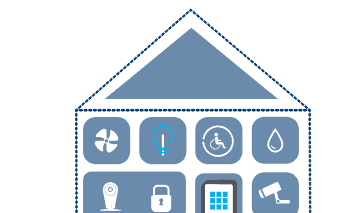This guide focuses on accessibility and home security if you or a loved one are hard of hearing, have vision loss or deal with mobility issues. With a simple gesture or preset routine, you have the ability to lock down your entire house at night, keep an eye on your kids throughout the day, open your garage door for delivery people to leave packages, and communicate with visitors at the front door even if you’re in bed.
Of course, it’s important to start with the basics: fire and carbon monoxide safety. The National Fire Protection Association identifies people with disabilities as being especially at risk in fires. Overhauling your smoke and carbon monoxide setup does wonders for home security, not to mention your safety.2
Table of Contents
- Table 1. Security Accessibility Considerations: Hard of Hearing, Mobility, Vision
- Todd Stabelfeldt and His Quadthedral
- 9 Tips, No Matter Your Specific Accessibility Needs
- Protecting Your Home for the Hard of Hearing
- Protecting Your Home: Mobility or Vision Issues
- Table 2. Examples of Accessible Security with a Smart Home
- Should You Get Professional Monitoring?
- Additional Resources
- References and Footnotes
Accessibility and Home Security
Check out the table below for an overview of the information in this guide.
Table 1. Security Accessibility Considerations
Hard of Hearing
- Get smoke/CO listening devices linked to bed shakers, strobe lights, and low-pitched 520 Hz audio alerts. Don’t forget traditional alarms. They must emit the T3 (smoke, three pulses) and T4 (CO, four pulses) sound patterns for the listening devices to “hear” them.
- It’s also good to have smart detectors/smart alert systems linked to smart lights, mobile notifications, and the like. Stay safer by using them in addition to listening devices, not instead of. (Note that some detectors such as Google Nest Protect don’t emit the T3/T4 sounds.)
- Set different lights, colors, and patterns to correspond with various triggers (smoke alarm blaring, doorbell ringing, oven going off, motion detected, etc.).
- For the most lighting variety, look into Phillips Hue smart lights.
- Get a smart doorbell camera to see who is at the door. You may even be able to lip-read what they are saying and respond without actually going to the door.
- Indoor and outdoor cameras throughout your property could be helpful, letting you see what set off various triggers. Cameras also allow you to keep an eye on kids and pets.
- Entry sensors and motion detectors let you know if someone has entered your home or is walking around outside.
- Choose text or email security notifications if you’d rather not deal with verbal phone notifications.
Mobility
- Consider a smart smoke/CO detector such as the Google Nest Protect. It tests itself, so you don’t need to ask for help, climb up a ladder or use a broom handle. Similarly, you can silence alerts remotely through the smartphone app. The Nest Protect tells you which room an emergency is in, and whether it is smoke or CO. The battery-powered version lasts about five years before the batteries need changing.
- If not using the Google Nest Protect, go with alarms that feature sealed, long-life batteries lasting 10 years.
- Automate all lights in your home for a high level of control wherever you are.
- Control doors, garage doors, doorbell cameras, TVs, instant pots, window blinds, plugs, outlets, and all types of smart home devices with your voice, smartphone, or switch control (iOS, Android). Communicate with visitors and convey instructions to them, no matter where you are.
- Use keychain remotes or fobs to control parts of your system, if you want.
- Lock down your home at night with smart lights, locks, blinds, and related smart accessories.
- Use motion- or voice-activated lights to navigate more easily when it’s dark (the Google Nest Protect has Pathlight for this purpose).
Vision
- The information in the mobility accessibility column applies here, too.
- Use doorbell cameras that give you the ability to share access. This way, you can get answers from sighted people you trust (“Who was that on the front porch at noon?”).
- Check out “Settings” and then “Accessibility” on your smartphone or tablet. Enable voice control, screen readers, magnifiers, larger text, and other features that make it easier to run the apps or hubs connected to your security devices.
Emergency Shutoff
The Google Nest Protect has Emergency Shutoff for CO and smoke. With CO, the Nest Protect communicates with the Nest Thermostat, if you have one, to shut off your gas, oil, or other fossil fuel heating system.
As for smoke emergencies, The Nest Protect can switch off fan-based, forced-air systems to prevent further spread of smoke. Electric systems won’t work with either type of shutoff.
Emergency Shutoff is not a substitute for evacuating as quickly as possible, but it may provide valuable extra time to get out.
If You Can’t Leave During CO Emergencies
If you have disabilities, it’s not always possible to get to fresh air and call 911. If you have no choice but to stay inside your home, experts recommend opening windows and doors, and switching off potential sources of CO. Smart home devices can help in both areas. For example, there are smart window, door and garage door openers, and emergency shutoffs.
- Never ignore CO alarms. Contact a technician or the fire department if alarms go off and no one has symptoms.
- Signs of CO poisoning include weakness, headache, dizziness, chest pain, vomiting, upset stomach, and confusion. CO poisoning can make you very ill and is sometimes fatal.
Does My Home Need a Carbon Monoxide Detector?
Probably. When in doubt, err on the side of caution. Your home needs CO detectors if it has at least one fuel-burning heater or appliance, a fireplace, or an attached garage.
Ideally, CO alarms would be installed on every level of the house and in every sleeping area. If you install only one CO alarm, put it in the main bedroom or just outside of it.
Todd Stabelfeldt and His Quadthedral
Todd Stabelfeldt is many things: husband, entrepreneur, computing technology expert and speaker, to name a few. He’s also a quadriplegic with no movement below his shoulders. He calls his home the Quadthedral, and it’s a marvel of automation. It features smart accessories such as door locks, window shades, lights, and garage door openers for independence and home security.
“Between Siri and Switch Control, I can use my phone just as good as anyone with 10 working fingers and hands,” Stabelfeldt told NBC News in 2017. He’s easily able to open the door, keep an eye on comings and goings, and let delivery folks in and out. “This technology just allows you to be you in your story,” Stabelfeldt explained.3
Find out more here on Stabelfeldt’s Quadthedral page.
9 Tips, No Matter Your Specific Accessibility Needs
Different people have different accessibility needs. That’s true even within the same disability. Get a group of 100 hard-of-hearing individuals together, and you have 100 unique sets of security preferences. However, here are nine general tips to keep in mind as you make your home more secure.
- Touch base with your local fire department. Fire departments sometimes distribute equipment to hard-of-hearing or deaf users for free.4 There may also be programs to address other disabilities. If nothing else, fire personnel can review your equipment, the viability of your evacuation plans, and make suggestions for improvement. Many times, personnel replace outdated smoke and CO detectors for free.
- Consider fire sprinklers: Fire sprinklers plus interconnected detectors and alarms are the best fire protection you have. The Home Fire Sprinkler Coalition points out that fire kills more than 2,500 people per year. Most at risk are folks with disabilities along with older adults and children.5
- Deadly heat and flames can build in less than a minute and half. After just three to five minutes, it may be too late for anyone inside a residence to survive, regardless of their abilities. Fire sprinklers put out smoke and fires early before they become destructive (or overly destructive).
- If you’re looking for apartments or houses, prioritize those that already have sprinklers.
- For new construction, fire sprinklers cost about $1.35 per square foot of sprinklered space, about the same amount you’d pay to upgrade carpeting.6 For retrofitting, the cost is higher at about $2 to $7 per square foot of sprinklered space.7
- The U.S. Fire Administration is investigating lower-cost sprinkler technologies for retrofitting. These technologies might not work as well as a comprehensive retrofit but could delay or eliminate flashover, giving residents more time to escape.8
- Interconnect smoke/fire/CO alarms and detectors: Interconnect your alarms to increase the chances of timely notification and safe evacuation.
- Keep important possessions within reach when you sleep: Hearing aids, eyeglasses, canes, wheelchairs, and cellphones are devices you may need if an emergency occurs. Keep them within easy reach of your bed. Think about lighting, too. Use touch lamps or smart lights on your bedside table.
- Keep your property well-maintained: Burglars equate untidy yards with homes that don’t have high security measures. Of course, it can be tricky to keep the yard mowed and the trees trimmed when you have a disability.
Do what you can to maintain your property. It’s fine to allot some of your security budget to pay for lawncare (and even smart sprinklers). As time goes on, devices such as robotic lawnmowers may become more affordable and easier to keep up.
Do avoid high privacy fences and view-blocking shrubbery. They prevent neighbors from witnessing a break-in. - Take special measures around doors and windows: Common burglar entry points are doors and windows. Keep them locked; smart locks are especially helpful.
Plus, burglars usually check first if someone is home. They listen for TVs or radios or knock on the door. When a person answers, the burglar makes up a story (missing dog, directions to nearby street, etc.). If you have a disability, you might not hear the door or make it there in time.
One solution is to have a video doorbell that lets you speak to visitors from wherever you are. If you are hard of hearing, another solution is to maximize door knock/doorbell alert lights and notifications. They’ll help you get to the door in time. A third path is to leave TVs and radios on, even if you’re not home. The sounds cause burglars to think someone is inside. You could also get a dog that barks when someone is near. Get a dog, if possible: Burglars dislike large dogs most, but even small dogs are great protection. They tend to get highly nervous, make noise, and are hard to calm down when agitated. The simple presence of a dog in your home is enough to stop most burglars in their tracks. Service dogs also let you know when someone’s at the door and when an alarm has sounded. (Some pet dogs do, too!)
- Deploy visible measures of security (cameras, signs, etc.): Burglars avoid homes with visible security measures such as cameras and burglar alarms. Even motion-detector lights, once they switch on, are usually sufficient to send burglars scurrying back into the dark.
Consider emergency or “panic” buttons next to your bed and throughout the house. Buttons are also available on pendants, smartwatches, and other mobile and wearable devices.
Sometimes, the buttons are part of a medical emergency alert system, other times a home security system. Either way, the system generally must be monitored for the buttons to deploy help when you press them. You decide during setup whether to summon emergency contacts, emergency personnel, or both, and in what order.
Protecting Your Home for the Hard of Hearing
Alarm accessibility has come a long way—kind of. These changes started with the 2007 publication of a paper, Waking Effectiveness of Alarms for Adults Who Are Hard of Hearing. Among the main findings:9
- Conventional, high-pitched T3 alarms awakened just 56% of hard-of-hearing subjects.
- Meanwhile, low-pitched alarms at the minimally required 75-decibel level awoke 92% of participants.
- 100% of the participants woke up when these low-pitched alarms sounded at 95 decibels.
- Bed and pillow shaker devices, by themselves, awakened 80% to 83% of study participants. Subjects 60 and older were less likely to be roused this way.
- Only 27% of subjects awoke when strobe lights went off.
These findings led to National Fire Protection Association code changes, at least in places such as hotels and motels, dorms, many assisted living communities, and apartment and condo buildings. These changes also help alcohol-impaired sleepers, medication-impaired sleepers, and children hear alarms better. These guidelines went into effect in 2014, seven years after the study was published. (Jurisdictions can develop their own codes, but most draw from NFPA recommendations.)
What about residential alarms? Do they now emit mixed or low-frequency (520 Hz) sounds like the alarms in hotels? Unfortunately, no. They still emit conventional, higher-frequency 3100 Hz sounds. That’s why listening devices are so important for home security.
If you are deaf or hard of hearing, regular alarms do not fully serve your needs. That’s true even if you hear well with hearing aids or cochlear implants. For instance, more than half of home fire deaths occur between 10 p.m. and 6 a.m. when many folks sleep and don’t have their aids on.10
Listeners “listen” for smoke and CO alarms to go off and then notify you accordingly. For instance, the Ring listener can send text notifications. Deaf-friendly listeners are especially useful since they can be connected to louder devices, bed shakers, flashing lights, and scrolling displays.
“Extensive studies have shown that almost all adults with normal hearing wake up within 32 seconds of the start of a standard 3100 Hz alarm at 60 decibels compared to only half of adults who are hard of hearing. This puts them at unacceptable risk of injury or death due to a house fire.”
– Susanne Jones, Customer Support Specialist for Healthy Hearing
Going Without Listeners
Some people who are deaf or hard of hearing use devices such as the Google Nest Protect. They do this even though these devices do not emit T3 and T4 patterns and don’t work with deaf-friendly listening
devices. These folks may set their systems to turn on all lights if a fire or CO emergency occurs. This type of approach may work if all residents:
- Wake up easily and quickly when the lights turn on
- Don’t sleep with sleep masks (or covers or pillows over their head)
- Aren’t at risk of deeper sleep from medication or alcohol
You know yourself best. That said, it’s generally safer to have deaf-friendly listeners in addition to (not instead of) smart systems. Smart systems can be great for daytime use or when you’re not home.
Top Options for Listening Devices
HomeAware Fire/CO Alert: HomeAware devices:
- “Listen” for T3 and T4 patterns
- Emit 105-decibel, 520 Hz alerts
- Use flashing strobe lights
- Run two-inch scrolling displays
- Employ bed shakers
Your device can become a fuller alert system if you want.
- Optional multiple alarm listeners to place around your home
- Bluetooth mobile connectivity sends alerts to your phone (separate phone transmitter required)
- Modules available for motion, door, and window sensors
- Direct connection to weather radio available
- System can serve as wake-up alarm and notify you of phone calls
- Optional alerts for babies crying, dogs barking, and phone calls
Serene Innovations: Like with HomeAware, you can limit a Serene Innovations system to just fire and CO or expand it a bit. Serene Innovations systems use a bright flasher, powerful bed shaker, and loud, audible sounds.
- Detect traditional smoke and CO audible alarms
- Can alert to any beeping audio signal
- Wearable notification system
- Sensors/transmitters available for baby cry, doorbell, motion detector lamp flasher, and more
SafeAwake alert device: The SafeAwake alert device is triggered by a conventional, T3 smoke alarm and is not for CO.
- Makes 520 Hz alarm sounds
- Emits flashing white lights
- Activates a bed shaker to wake sleepers
The SafeAwake doesn’t display the time. It cannot be used as a wake-up alarm.
Not a Listening Device but an Actual Alarm
Gentex 7139CS and 7139LS: These Gentex smoke alarms emit the traditional 3100 high-frequency sound, pairing it with a visual strobe light alarm.
- Both models come in 120VAC with 9V battery back-up.
- The LS is portable and single-station, featuring a 9-foot-long electrical cord.
- The LS doesn’t require an electrician’s help to install, but the CS does.
- The CS is hardwired and can be single or multi-station (interconnected).
- A small bracket comes with the alarms to prevent accidental unplugging.
There’s no lower-frequency alert or tactile component such as bed shaking. Note that the NFPA does not recommend this type of device for older adults.11 Choose it only if you’re certain a strobe light will wake you. Remember that alcohol and medications interfere with your ability to awaken quickly, too.
Lights, Mobile Messages, and Other Smart “Notifications”
It’s good to incorporate smart lights, mobile notifications, and other aids into your alert system, especially if you have the budget. Do avoid using a “smart” system entirely by itself. As mentioned earlier, fires frequently occur when people are asleep. Bed shakers and 520 Hz sounds together are your best bets to wake up quickly.
Mobile notifications and smart lights definitely serve a purpose during the daytime and even at night for baby cries, break-ins, and other emergencies. They come in handy if you’re away from home, too.
- Look into Phillips Hue smart lights. Set different lights, colors, and patterns for each trigger. Get alerted when someone knocks on the door, when your oven timer goes off, or when the baby cries.
- Get a smart doorbell that includes a video camera. That way, you can see who is at the door, perhaps even lip-read what they are saying, and respond, all without actually going to the door.
- Get some alerts sent to your Bluetooth-enabled hearing aids, if you want (these capabilities are good for phone and TV listening, too).
- Indoor and outdoor cameras throughout your property let you see what set off a trigger.
- Entry sensors and motion detectors let you know if someone has entered your home or is walking around.
- Choose text or email notifications if you’d rather not deal with phone notifications.
- Use hubs to set up and control more complex systems.
If you’re looking for a professionally installed system, consider ADT Pulse. It includes a high level of home automation and customization. Name the device, and it’s there (lights, thermostats, garage door, doorbell camera, indoor and outdoor cameras, doors, locks, strobe lights for carbon monoxide and fire, flood sensors, window and door sensors, and more).
Otherwise, DIY devices/systems such as Alexa Guard and Apple HomeKit can incorporate door and window sensors, smart lights, outlets, cameras and sprinklers, among many other accessories.
Protecting Your Home: Mobility or Vision Issues
Digital, voice-activated assistants are especially useful for vision or mobility accessibility. For example, Google Assistant, Alexa, and Siri let people control security devices with just their voices. Before we dive into that, though, let’s explore some basics.
The Basics: Fire Safety Recommendations
Basic fire safety recommendations are even more important for folks with mobility or vision disabilities.
- Sleep on the ground floor for quicker exit in case of fire.
- Practice escape plans at least twice a year. If you have a service animal, practice with it, too.
- Aim for two exit routes from each room and establish a meeting place outside of the home.
- Install smoke detectors or alarms in every sleeping room, outside each sleeping area, and on each level of the house. Interconnect the alarms, if possible.
- Test your alarms at least once monthly. It’s possible to get Google Nest Protect alarms that don’t require you to climb up a ladder and press a button. They self-test, too. Otherwise, if you need help, ask a relative, friend, neighbor, or your local fire department.
- Replace CO alarms about every five years and smoke alarms every 10 years.
- Stay low and crawl when escaping during a fire, if possible (during drills, too). Touch doors with the back of your hand. If they’re too hot, use your alternative exit.

Selecting the Right Types of Alarms
Traditional smoke/CO alarms may not be friendly to you for several reasons.
Potential Problems
- If you have vision loss, you likely rely on your hearing even more. Unfortunately, traditional alarms make sounds that could overload your senses and cause confusion during an emergency.
- It’s difficult or impossible to change the batteries on your alarm. Ditto with testing the alarm.
- Some detectors are prone to false alerts. Rather than climb up a ladder, which you might not be able to do, you eventually just disable the alarm and go without a warning system.
Solutions
- Use hardwired alarms or sealed (long-life) batteries that last up to 10 years. (Note that batteries in the battery-powered Google Nest Protect last about five years, not 10.)
- Look for alarms that pause between cycles, giving you time to hear instructions or even any directives from a firefighter nearby.
- Get wireless detectors that use remote controls or key fobs. You can test and “hush” these detectors from a distance.
- Choose the Google Nest Protect. Wirecutter even calls it the only smart smoke alarm worth buying. The Protect tests itself, detects fast-burning and slow-burning fires, and warns you with voice alerts before its siren goes off. It also lets you know which room the emergency is in and whether it is fire or CO. Silence it with the companion app (or press the mute button on the alarm itself).
Doorbell Cameras
If you have mobility issues, you might not be able to reach the door quickly or at all. A smart doorbell camera lets you:
- See who is at the door
- Communicate remotely with visitors, whether they’re delivery people, neighbors, friends, family, or even would-be burglars checking whether anyone is home
- Store video to review later
- Operate it via Alexa or other digital assistants, using your voice
- Integrate it with other smart devices (depends on brand and compatibility)
One example is the Ring Doorbell 3. It offers motion detection, triggered recording, Alexa voice control, HD video, and night vision.
Meanwhile, the Nest Hello has facial recognition technology to identify people you know. So, it can be particularly useful for vision accessibility. On the con side, the facial recognition technology requires a Nest Aware subscription. The subscription does also give you package delivery notifications and the ability to view recorded video. Subscriptions start at $6 a month and cover all cameras, speakers, and displays in your Nest network.
Smart Locks, Smart Lights, and Other Smart Home Devices
Smart locks and smart lights let you lock and secure your home without relying on your movement or sight. You can set security routines based on the time of day, another device’s behavior, your location (or someone else’s location), or a voice trigger.
If you own Alexa-enabled devices, one option for shutting down the house at night is to say a trigger phrase such as, “Alexa, please close the house down” (choose whatever phrase you like). Alexa then carries out the routine, which might go like this:
- Turn off all lights except outdoor security and porch lights
- Lock all doors
- Lower the window blinds
Setup is through the Alexa app. Devices you could use include:
Light bulbs: Automate all of the lights in your home if you want. Control lights with your voice, use them to illuminate your way to the bathroom at night, or turn them on and off randomly so people think you’re walking around when you’re not.
Locks: Enter your house more easily with locks that sense your presence when you approach the door. Others use fingerprint access. Secure your house at any time, whether you are home, on vacation, or having a hard time getting off the couch.
Garage door openers: Let delivery people into your garage so you can retrieve packages when you’re able. This approach also minimizes the chances of package theft.
Door and window openers: Let pets out, allow visitors in, and enjoy the weather when it’s nice.
Plugs and outlets: Control plugged-in devices with voice commands, schedules, or timers. Start a crockpot meal in the kitchen while you’re in the bedroom or turn off a device that has been left on too long.
Table 2: Examples of Accessible Security with a Smart Home
Concern
A hard-of-hearing resident is worried that he won’t be aware of someone breaking in at night
Solution
The resident sets a rule for his alarm system; anytime it goes off, all the lights in the house turn on. The lights and alarm noise will deter most, if not all, burglars and probably awaken the resident.
The resident can check indoor and outdoor cameras’ live and stored feeds for signs of entry and exit. He can also check smartphone notifications to see which sensors and alarms were involved. If the system is monitored, he can ask that responders come immediately (or not, depending on the situation and his preferences).
A homeowner with mobility and fine motor issues loves her grandkids, but they’re always climbing in and out of the windows. The homeowner worries that a burglar could crawl through a window left open (open windows aren’t great for the utility bills, either).
Motion sensors on each window notify Grandma when a window has been opened (and left open). Grandma makes sure all the windows are closed and locked before the grandkids leave.
Another solution: Grandma could use smart window sliders and openers to control the windows remotely. The grandkids probably won’t be able to open the windows manually, but they’ll find other ways to entertain themselves.
A homeowner who is blind frequently has packages delivered to her home. The packages are often hard to find, and sometimes they get stolen.
If the homeowner has a garage: She receives an alert (whether or not she’s home) when the regular delivery driver pulls into her driveway. She then remotely opens the garage door. The driver leaves the packages inside the garage and heads out. The homeowner then closes the garage door. When she gets new drivers, she uses smart speakers/doorbell camera systems to reroute them from the front door to the garage.
If the homeowner doesn’t have a garage: The homeowner can speak with the driver at the front door (from wherever she is) to discuss drop-off location and number of packages. If the boxes later get stolen, the homeowner can ask sighted users or the authorities to review video footage.
Both members of a married couple are hard of hearing. One works from home, while the other works outside of the house. They have children of various ages, including kids who do online school at home while the parents work. The parents want to track their children’s movements throughout the day to ensure the children’s safety.
Indoor and outdoor cameras let the parents keep an eye on where their kids are and what they’re doing. Sensors, detectors, smart lights, and mobile notifications combine to let the parents know about crying, alarms, or other triggers.
A person with limited mobility has the habit of forgetting to lock the front door (so does his housekeeper).
He gets a keyless smart lock installed. It sends notifications when the door isn’t locked, and he can control the lock from wherever he is. He gives housekeepers and other personnel their own individual user codes so he can track exactly when they come and go.
A homeowner with vision and mobility needs has a hard time navigating and turning lights on.
The homeowner gets all smart lights. He controls them with his voice and through routines and motion sensors. He’s able to get around his house much better now.
Should You Get Professional Monitoring?
Investigate professional monitoring if you have at least one of these concerns:
- Fear of getting trapped during an emergency
- Not being able to make phone calls in a hurry
- Not realizing an emergency is occurring
- Whether emergency responders will arrive in time
- Dealing with game plans for every imaginable situation
To elaborate on the last point, suppose you go out to eat. Your self-monitored system notifies you in the middle of dinner that fire alarms are going off at home or that someone has opened your door and is apparently in the house. Would you notice the notification right away and know immediately what to do? You must also have your phone with you all the time and never set it to “Do Not Disturb.”
With professional monitoring, dispatchers call you or notify your emergency contacts/the appropriate authorities if an alarm goes off. Professional monitoring is valuable in burglaries, fires, and carbon monoxide situations, among others. It costs about $10 to $50 per month.
Accessibility and Home Security
If you don’t have a disability, you almost certainly know people who do. Moreover, you could become disabled yourself at any moment. Fortunately, home security is accessible on many levels. Start with the basics such as fire and carbon monoxide detection. Work your way up from there, depending on your needs, goals, and budget.
Additional Resources
The Quadthedral: The Dream of the Customized Stabelfeldt Home
Home Fires: An Overview from Ready.gov
References and Footnotes
- Disability Impacts All of Us. (n.d.). Centers for Disease Control and Prevention. Retrieved October 13, 2020, from https://www.cdc.gov/ncbddd/disabilityandhealth/infographic-disability-impacts-all.html
- People with Disabilities. (n.d.). National Fire Protection Association. Retrieved October 13, 2020, from https://www.nfpa.org/Public-Education/Fire-causes-and-risks/Specific-groups-at-risk/People-with-disabilities
- Sottile, Chiara. (2017, May 09). How a Smart Home Empowers People with Disabilities. NBC News. Retrieved October 13, 2020, from https://www.nbcnews.com/tech/tech-news/how-smart-home-empowers-people-disabilities-n756731
- Dorsey, David. (2018, February 7). Cape Coral Fire Department Puts FEMA Grant to Use for Deaf, Hard of Hearing Fire Alarms. The News-Press. Retrieved October 13, 2020, from https://www.news- press.com/story/news/2018/02/07/cape-coral-fire-department-puts-fema-grant-use-deaf-hard-hearing-fire-alarms/310912002/
- Fire Sprinkler Facts. (n.d.). Home Fire Sprinkler Coalition. Retrieved October 13, 2020, from https://homefiresprinkler.org/fire-sprinkler-facts/
- Frequently Asked Questions. (n.d.). Home Fire Sprinkler Coalition. Retrieved October 13, 2020, from https://homefiresprinkler.org/fire-sprinkler-answers/
- How Much Does a Fire Sprinkler System Cost? (n.d.). Guardian Fire Protection. Retrieved October 13, 2020, from https://www.guardianfireprotection.com/blog/faq-fire-sprinkler-system-cost/
- Retrofitting Homes with Lower Cost Sprinkler Technologies. (2020, May 27). The U.S. Fire Administration. Retrieved October 13, 2020, from https://www.usfa.fema.gov/current_events/052720.html
- Bruck, Dorothy, and Thomas, Ian. (2007, January). Waking Effectiveness of Alarm (Auditory, Visual and Tactile) for Adults Who Are Hard of Hearing. Retrieved October 13, 2020, from https://www.researchgate.net/publication/37376795_Waking_effectiveness_of_alarm_auditory_visual_and_tactile_for_adults_who_are_hard_of_hearing
- Most Fire Deaths Happen in the Middle of the Night. (n.d.). FDNY Foundation. Retrieved October 13, 2020, from https://www.fdnysmart.org/10pm-6am/
- Safety Materials for People Who Are Deaf or Hard-of-Hearing. (n.d.). National Fire Protection Association. Retrieved October 13, 2020, from https://www.nfpa.org/Public-Education/Fire-causes-and-risks/Specific-groups-at-risk/People-with-disabilities/Educational-materials/People-who-are-deaf-or-hard-of-hearing#

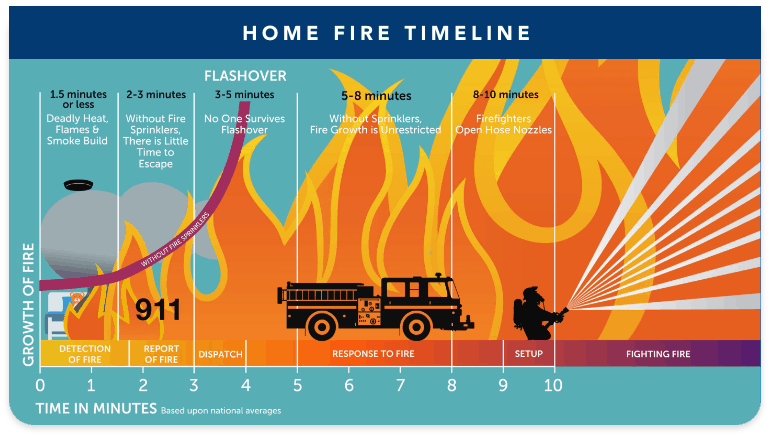
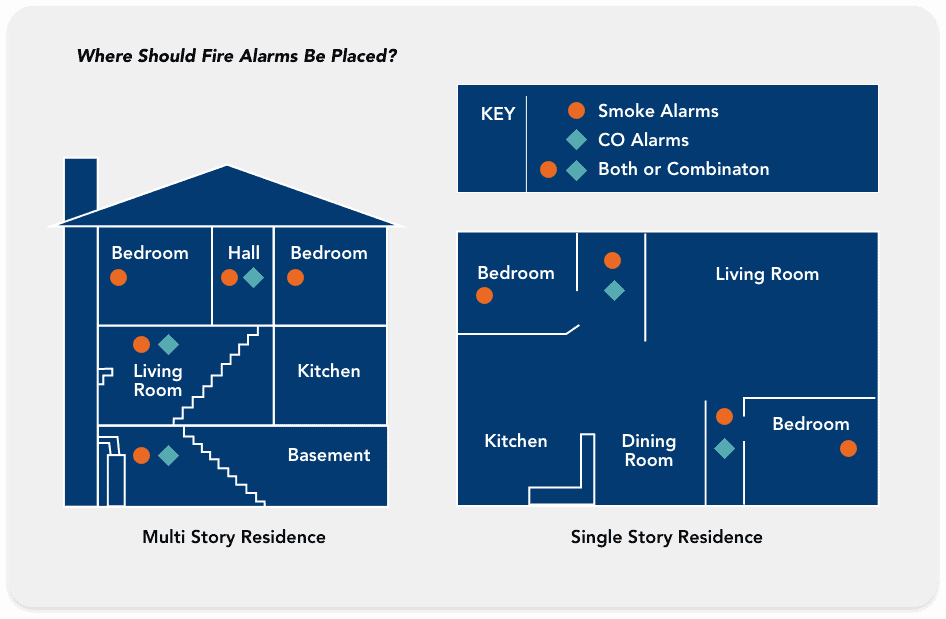
 Do what you can to maintain your property. It’s fine to allot some of your security budget to pay for lawncare (and even smart sprinklers). As time goes on, devices such as robotic lawnmowers may become more affordable and easier to keep up.
Do what you can to maintain your property. It’s fine to allot some of your security budget to pay for lawncare (and even smart sprinklers). As time goes on, devices such as robotic lawnmowers may become more affordable and easier to keep up.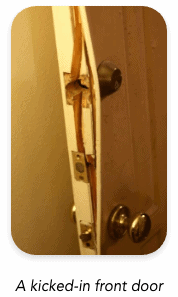 Plus, burglars usually check first if someone is home. They listen for TVs or radios or knock on the door. When a person answers, the burglar makes up a story (missing dog, directions to nearby street, etc.). If you have a disability, you might not hear the door or make it there in time.
Plus, burglars usually check first if someone is home. They listen for TVs or radios or knock on the door. When a person answers, the burglar makes up a story (missing dog, directions to nearby street, etc.). If you have a disability, you might not hear the door or make it there in time. Get a dog, if possible: Burglars dislike large dogs most, but even small dogs are great protection. They tend to get highly nervous, make noise, and are hard to calm down when agitated. The simple presence of a dog in your home is enough to stop most burglars in their tracks.
Get a dog, if possible: Burglars dislike large dogs most, but even small dogs are great protection. They tend to get highly nervous, make noise, and are hard to calm down when agitated. The simple presence of a dog in your home is enough to stop most burglars in their tracks. 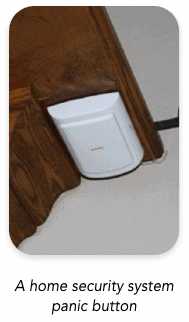 Consider emergency or “panic” buttons next to your bed and throughout the house. Buttons are also available on pendants,
Consider emergency or “panic” buttons next to your bed and throughout the house. Buttons are also available on pendants, 
